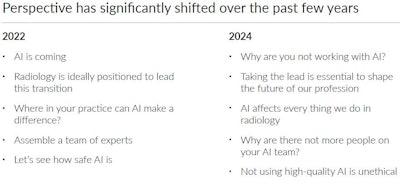Test an AI product in your own clinical workflow for several weeks or months, run a pilot scheme, and don't settle for demos. These were among the key recommendations made by Prof. Tim Leiner, PhD, of the Mayo Clinic during a session at ECR 2024.
"Judge by YOUR success metrics; only decide after thorough evaluation," he said. "Collect feedback from as many radiologists and clinicians as you can and don't forget residents."
Radiologists should sharpen their approach to adopting AI innovations because it is rapidly becoming "unethical" to ignore them, according to Leiner, a cardiovascular radiologist and professor of radiology. "Departments would be wise to create a vision on AI, working out where they're going to implement it and how and where the resources will come from."
There are now some high-quality AI products available, with good evidence to support their use, and they can improve areas of practice such as detection of abnormal findings, he said. But there are many other products still being marketed without proper evidence of clinical benefit. "The fact a product has regulatory approval does not mean that there is evidence of clinical efficacy; it doesn't mean it's a good product."
Leiner, a former president of the International Society of Magnetic Resonance in Medicine (ISMRM), said AI would be applied to steps across the radiology workflow, such as patient indication setting, scheduling, image gathering, and prognosis. It can aid image quality, reduce radiation dose, optimize protocols to reduce scan times and contrast agent dose, and automate quantification and measurement of findings.
"It can reduce tedious tasks, which is a big advantage if it works and it works well," he said. "There is software out there that can generate impressions or conclusions for the (radiologist's) report. All of this can hopefully reduce burnout rates or you can also use these advantages to generate higher throughout and have people reading more studies each day."

The field is developing rapidly, according to Leiner. As of December 2023, there were nearly 700 "market-cleared" radiology AI algorithms in the U.S. More than 80% were medical imaging algorithms, which includes algorithms in cardiology and other fields.
More vendors were also appearing at major radiology conferences promoting AI products, but Leiner questioned if these were addressing clinical needs, highlighting a dearth of validated use cases. He cited one research study of 100 commercially available AI products, in which nearly two-thirds (64) had no peer-reviewed evidence, while around half of studies were sponsored by companies developing the AI.
Leiner also looked at recent data on actual adoption of AI. A "concerning" 40% of academic hospitals still didn't use AI significantly, he said, while many hospitals appeared to be reserving budgets hoping to attract funders such as healthcare insurers, he said.
"That's not going to happen" he predicted, describing a recent participation on a panel with insurers. "They all said this will have to come from increases in efficiency in radiology. They would only consider paying if hospitals generated very high quality evidence that AI could reduce costs or yield other outcome benefits."
Leiner said perspectives on AI had changed over the past couple of years and it was now incumbent on radiologists, who were going to be the most impacted of professionals, to take the lead with the technology and ensure it could benefit patients.
Describing a seven-step program adopted at the Mayo Clinic to introduce and deploy AI, he recommended delegates should focus on creating a "platform" -- not just algorithms -- make a clear case for clinical use identifying problems that needed to be solved, and assemble comprehensive teams of experts including clinicians, AI, IT and informatics specialists.
Leiner was asked by the audience to advise radiologists who might be looking to convince their stakeholders or departments to develop AI, where they might start.
"I think a really low hanging fruit is to implement AI techniques to denoise images in the image domain," he said. "At Mayo, we have developed our own algorithm for this purpose, so every CT scan from our more than 40 CT scanners goes through this algorithm. This has had a huge impact, so you can make significant gains in terms of reducing dose this way."
Consider co-creating your own solution, he recommended. Creation of AI algorithms has been democratized, and many vendors are interested in co-creation.
"There is a lot of software out there that can do automatic measurements. For example, in cardiovascular imaging a huge time sink is doing aortic measurements manually. There are examples that in every subspecialty of radiology you can find. Focus on those really labor-intensive managements," Leiner concluded.




















